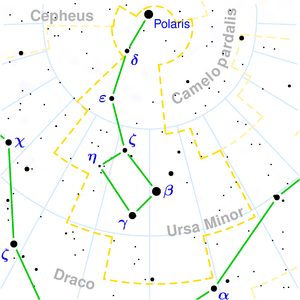|
|
Ursa Minor is a constellation in the northern sky, the name of which means Little Bear in Latin. It is one of the 88 modern constellations, and was also one of the 48 listed by Ptolemy. It is notable as the location of the north celestial pole, although this will change after some centuries due to the precession of the equinoxes.[1] Notable features Ursa Minor is colloquially known as the Little Dipper because its seven brightest stars seem to form a ladle, or dipper shape. The star at the end of the dipper handle is Polaris, the North Star. Polaris can also be found by following a line through the two stars which form the end of the "bowl" of the Big Dipper, a nearby asterism found in the constellation Ursa Major. Polaris (α UMi), the brightest star in the constellation, is a yellow supergiant shining at 2.02 apparent magnitude . It belongs to the rare class of Cepheid variable stars. Only a bit less bright is β UMi (Kochab), a 2.08 orange giant star. The four stars in the "bowl" of the little dipper are unusual in that they are of second, third, fourth and fifth magnitude. Hence they provide an easy guide to determining what magnitude stars are visible, useful for city dwellers or testing your eyesight. Notable deep sky objects Ursa Minor Dwarf, a dwarf galaxy, is located in the area of the constellation. History and Mythology The constellation of Ursa Minor, when including its dimmer stars, vaguely resembles a baby bear with an unusually long tail. In consequence, Ursa Minor and nearby Ursa Major, the Great Bear, formed the basis of the myth of Callisto and Arcas. The tail was said to have been lengthened from that usually expected for a bear, due to its being held by the tail and spun around the pole. In a variant of the story, in which it is Boötes that represents Arcas, Ursa Minor was considered to represent a dog. This is the older tradition which sensibly explains both the length of the tail and the obsolete alternate name of Cynosura (the dog's tail) for Polaris, the North Star. (It also clarifies the otherwise inexplicable etymology of "cynosure.") [2] Previously, Ursa Minor was considered to be just seven close stars, mythologically regarded as sisters. In early Greek mythology, the seven stars of the Little Dipper were considered to be the Hesperides, daughters of Atlas. Together with the nearby constellations of Boötes, Ursa Major, and Draco, it may have formed the origin of the myth of the apples of the Hesperides, which forms part of the Labours of Hercules. In earliest times, Ursa Minor was named the Dragon's wing, and was considered a part of Draco. The dragon's wing as an asterism is now long forgotten. In other cultures, Ursa Minor was the hole in which the earth's axle found its bearing. In Hindu mythology, the Pole Star is Dhruva (the word means pole today), and there is a story behind him becoming a star. See also * Ursa Major Citations 1. ^ Guilherme de Almeida (2004). Navigating the Night Sky: How to Identify the Stars and Constellations. Springer. ISBN 1852337370. 2. ^ Allen, Richard Hinckley (1969). Star Names: Their Lore and Meaning. Dover Publications Inc. (Reprint of 1899 original). ISBN 0-486-21079-0. References * Ian Ridpath and Wil Tirion (2007). Stars and Planets Guide Links
Retrieved from "http://en.wikipedia.org/"
|
|
||||||||||||||||||||||||||||||||||||||||||||||||||||
